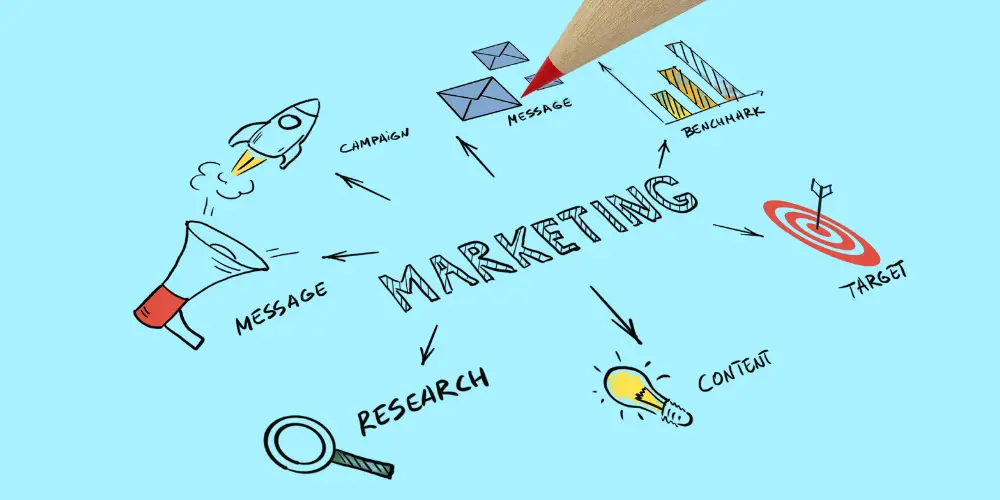Last Updated on 1 year ago by Ecem Ertürk
By leveraging direct marketing and indirect marketing techniques effectively, businesses can achieve the best possible results and maximize their marketing efforts. In this article, we will explain the difference between direct and indirect marketing, explore their advantages and disadvantages, and provide practical insights on how to incorporate both strategies into a cohesive marketing plan.
Direct marketing involves reaching out directly to potential customers to promote products or services. It can take various forms, such as commercials, content marketing, sales calls, email marketing, and direct mail. On the other hand, indirect marketing focuses on building brand awareness and loyalty over time. Strategies like content marketing, social media marketing, sponsored content, and affiliate programs fall under indirect marketing.
Understanding Direct and Indirect Marketing
In the world of marketing, understanding the concepts of direct and indirect marketing is crucial for devising effective strategies. Direct marketing involves directly asking potential customers to purchase a product or service. This approach is often characterized by targeted advertising campaigns, sales calls, email marketing, and direct mail. On the other hand, indirect marketing focuses on building brand awareness and loyalty over time to generate business. This strategy utilizes methods such as content marketing, social media marketing, sponsored content, and affiliate programs.
Both direct and indirect marketing have their own variations and complexities. Direct marketing aims to make immediate connections with customers, while indirect marketing takes a longer-term approach by nurturing relationships and building brand reputation. By understanding these strategies, businesses can create a marketing plan that combines the strengths of both approaches, maximizing their impact and generating long-lasting results.
Direct Marketing: Connecting with Customers Directly
In the world of marketing, direct marketing is a powerful strategy that allows businesses to connect with customers in a more personalized and direct manner. By reaching out to customers directly, businesses can deliver targeted messages and offers, creating a sense of exclusivity and urgency.
Direct marketing encompasses a variety of methods, each with its own advantages and disadvantages. One popular example is commercials, where businesses showcase their products or services through television or online advertisements, capturing the attention of potential customers.
Sales calls are another direct marketing technique, where businesses directly contact customers over the phone to pitch their offerings. This method allows for real-time communication and immediate responses, making it a valuable tool for lead generation.
Email marketing is a widely used direct marketing strategy that involves sending targeted emails to potential or existing customers. This approach allows businesses to nurture customer relationships, deliver personalized content, and drive conversions.
Direct mail is a traditional but effective method of delivering marketing materials, such as brochures, postcards, or catalogs, directly to customers’ mailboxes. This tangible approach can capture customers’ attention, particularly in a digital age saturated with online advertisements.
Although direct marketing presents numerous advantages, such as the potential for immediate results and targeted messaging, it also has its downsides. One challenge is the risk of desensitizing the audience. As customers are bombarded with advertising messages through various channels, it’s crucial for businesses to strike a balance and avoid overwhelming their target audience.
Multiplying Your Impact with Indirect Marketing

Indirect marketing is a powerful strategy that can greatly expand the reach and impact of your marketing campaign. By leveraging various indirect marketing tactics, businesses can effectively build brand awareness, engage customers, and generate long-term results.
- Content Marketing: Content marketing involves creating and sharing valuable, relevant, and consistent content to attract and retain a clearly defined audience. By consistently providing informative and engaging content, businesses can establish themselves as industry thought leaders and build trust with their target audience.
- Social Media Marketing: Social media platforms offer a highly effective avenue for brand exposure and customer engagement. Through strategic social media marketing, businesses can leverage the power of platforms such as Facebook, Instagram, LinkedIn, and X (Twitter) to reach a wider audience, amplify their brand message, and generate user-generated content.
- Sponsored Content: Sponsored content refers to the practice of partnering with influential individuals or publications to create and promote content that aligns with your brand. By collaborating with these influencers, businesses can tap into their existing audience and benefit from their credibility and expertise.
- Affiliate Programs: Another powerful strategy in indirect marketing is the establishment of affiliate programs. By partnering with affiliates, businesses can leverage the reach and influence of affiliates’ networks to promote their products or services. When affiliates successfully refer customers, they receive a commission, incentivizing them to actively promote the brand.
While indirect marketing strategies have the potential to multiply your marketing impact, it is essential to address some challenges. Tracking performance and measuring the return on investment (ROI) of indirect marketing campaigns can be complex. However, with the right tracking tools and analytics in place, businesses can gain valuable insights into the effectiveness of their indirect marketing efforts and make data-driven decisions to optimize their strategies. Additionally, consistent effort and a long-term perspective are crucial in realizing the full benefits of indirect marketing.
Incorporating indirect marketing strategies into your overall marketing plan can yield significant results. By utilizing content marketing, social media marketing, sponsored content, and affiliate programs effectively, businesses can expand their reach, engage customers, and ultimately multiply their marketing impact.
Pros and Cons of Direct and Indirect Marketing
In the world of marketing, both direct and indirect strategies play a crucial role in reaching and engaging target audiences. Understanding the pros and cons of each approach is key to developing an effective marketing plan that aligns with business goals and objectives. Direct marketing offers several advantages. One of the main benefits is the ability to achieve immediate results. By directly reaching out to potential customers through methods such as sales calls, email marketing, and direct mail, businesses can generate quick responses and conversions. Additionally, direct marketing allows for targeted messaging, ensuring that the right message is delivered to the right audience, increasing the likelihood of a positive response.
However, direct marketing also has its drawbacks. One disadvantage is the potential risk of spamming or overwhelming recipients with promotional content. This can lead to a negative brand perception and decreased effectiveness of direct marketing efforts. Furthermore, direct marketing requires strategic advertising placements to effectively reach the target audience, which can be costly and time-consuming.
On the other hand, indirect marketing has its own set of advantages. Building brand reputation and awareness is one of the key strengths of indirect marketing. Strategies such as content marketing, social media marketing, sponsored content, and affiliate programs focus on creating valuable and engaging content that resonates with the audience. By indirectly promoting products or services, businesses can cultivate long-term relationships with customers, leading to increased loyalty and trust.
Despite its benefits, indirect marketing has its challenges. One of the main disadvantages is the difficulty in tracking performance and measuring results. Unlike direct marketing, where immediate responses can be tracked, indirect marketing efforts often require more time and effort to gauge their impact. Additionally, implementing and maintaining successful indirect marketing strategies require consistent effort and ongoing investment.
Incorporating Direct and Indirect Marketing in a Cohesive Strategy

In today’s competitive business landscape, incorporating both direct and indirect marketing strategies is crucial for success. By integrating these two approaches into a cohesive marketing plan, businesses can maximize their marketing impact and build strong customer relationships.
Direct marketing allows businesses to connect directly with their target audience. Through channels such as commercials, sales calls, email marketing, and direct mail, businesses can deliver customized messages and offers, resulting in immediate responses from potential customers. However, it is essential to strike a balance and not overwhelm the audience with excessive direct marketing, as this can lead to desensitization and decreased effectiveness.
On the other hand, indirect marketing focuses on building brand awareness and loyalty over time. Strategies such as content marketing, social media marketing, sponsored content, and affiliate programs help businesses reach a broader audience and establish their reputation as industry leaders. While indirect marketing may take longer to yield results, it offers long-term benefits and the opportunity to build lasting customer relationships.
The key to successfully incorporating both direct and indirect marketing lies in leveraging their respective strengths. By combining direct marketing’s immediate response capabilities with the long-term impact of indirect marketing, businesses can create a powerful marketing strategy that drives both short-term sales and long-term brand loyalty.
When integrating these strategies, it is essential to maintain consistency in messaging and branding across all channels. By ensuring that the messages delivered through direct marketing align with the overall brand image conveyed through indirect marketing efforts, businesses can create a cohesive and unified customer experience, strengthening their brand identity.
Furthermore, businesses must continually monitor and analyze the performance of their marketing campaigns to make data-driven decisions and optimize their strategies. By tracking the effectiveness of direct and indirect marketing efforts, businesses can identify trends, adjust their tactics, and allocate resources effectively to maximize their marketing ROI.
Direct and Indirect Marketing Examples in Action
This section is dedicated to showcasing real-world examples of direct and indirect marketing strategies in action. By highlighting successful campaigns implemented by businesses, we aim to illustrate the effectiveness of both approaches and provide inspiration and education for our readers.
Direct Marketing Examples:
- Commercials: We explore how companies like Coca-Cola and Nike effectively utilize television and online commercials to directly target their audience and promote their products.
- Sales Calls: Companies like Salesforce and HubSpot demonstrate how personalized sales calls can help establish direct connections with potential customers and drive conversions.
- Email Marketing: We examine successful email marketing campaigns by companies such as Amazon and Airbnb, highlighting their strategies for engaging subscribers and driving sales.
- Direct Mail: Companies like IKEA and Home Depot show how direct mail can effectively reach customers and generate leads by combining physical advertising with targeted messaging.
Indirect Marketing Examples:
- Content Marketing: We explore how brands like Red Bull and Blendtec leverage high-quality content, such as blogs and videos, to indirectly engage and influence their target audience.
- Social Media Marketing: Companies like Starbucks and Oreo demonstrate how social media platforms, such as Instagram and X (Twitter), can be used to build brand awareness and foster customer engagement.
- Sponsored Content: We showcase successful partnerships between brands and content creators, like GoPro’s collaboration with popular YouTubers, to illustrate the power of sponsored content in reaching new audiences.
- Affiliate Programs: Companies like Amazon and Airbnb demonstrate how affiliate marketing can leverage influencers and affiliates to promote their products or services and generate sales on a performance-based model.
Through these diverse examples, readers will gain a deeper understanding of direct and indirect marketing strategies and be equipped with practical insights to implement these strategies in their own businesses.
Maximizing ROI Through Direct and Indirect Marketing Synergy
When it comes to marketing, the ultimate goal for any business is to maximize return on investment (ROI). One effective way to achieve this is by leveraging the synergy between direct and indirect marketing strategies. By combining these two approaches, businesses can optimize their marketing efforts and achieve better results.
Direct marketing focuses on immediate sales and reaching out directly to potential customers. On the other hand, indirect marketing emphasizes building brand awareness and loyalty over time. By incorporating both strategies into a cohesive marketing plan, businesses can create a powerful combination that maximizes the impact of their marketing efforts.
When implementing direct and indirect marketing together, businesses can benefit from the strengths of each strategy. Direct marketing tactics such as email marketing and targeted advertisements can generate immediate sales and drive immediate results. At the same time, indirect marketing techniques like content marketing and social media advertising can help build long-term relationships with customers and enhance brand reputation.
To measure and optimize ROI in a comprehensive marketing strategy, it is important to track and analyze the performance of both direct and indirect marketing efforts. By monitoring key metrics such as conversion rates, customer acquisition costs, and customer lifetime value, businesses can identify areas for improvement and make data-driven decisions to enhance their marketing campaigns.












